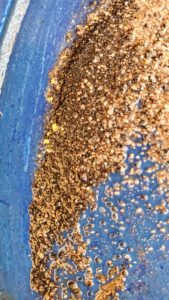Gold Prospecting Highbanking Tips
Gold prospecting tips and tricks learned over the years!
Finding gold ain’t easy but with the right tools and skills you will be armed to get out there and finding that GOLD!
Gold Prospecting Highbanking Tips

gold in the pan
We get the highbanker dialed in. Setup the secondary sluice box with Dream Mat and finish off gold panning some highgrade Colorado Gold!
Your my type of miner … The smart kind !! Efficiency means more gold in less time . Where you put your tailings and the direction you work your grounds are all common sense but many miners overlook these things in there haste for color….
The gravel and rock look pretty free of fine dirt/mud filling the gaps which usually indicates it has been worked and re-worked by previous miners, and not too long ago. Finding only fine gold is another indication of working old diggings. Did your initial panning indicate this area was better than it turned out? Seems like a lot of work to set everything up and work hard all day for pennies. If you did this for educational purposes, well . . . that’s another story. I loved the way you explain things as you go along. Great video.
Reply: Your assumptions/evaluations are mostly correct. Parts of this area have been worked in the past but we seek out the virgin ground amongst the tailings. Colorado in general is known as a fine gold state. A vast majority of the gold here is extremely fine in character.
From Wikipedia, the free encyclopedia:
The Pike’s Peak Gold Rush, which followed the California Gold Rush by approximately one decade, produced a dramatic but temporary influx of migrants and immigrants into the Pike’s Peak Country of the Southern Rocky Mountains. The rush was exemplified by the slogan “Pike’s Peak or Bust!”, a reference to the prominent mountain at the eastern edge of the Rocky Mountains that guided many early prospectors to the region westward over the Great Plains. The prospectors provided the first major European-American population in the region.
The rush created a few mining camps such as Denver City and Boulder City that would develop into cities. Many smaller camps such as Auraria and Saint Charles City were absorbed by larger camps and towns. Scores of other mining camps have faded into ghost towns, but quite a few camps such as Central City, Black Hawk, Georgetown, and Idaho Springs survived.
For many years, people had suspected the mountains in present-day Colorado contained numerous rich gold deposits. In 1835, French trapper Eustace Carriere lost his party and ended up wandering through the mountains for many weeks. During those weeks he found many gold specimens which he later took back to New Mexico for examination. Upon examination, they turned out to be “pure gold”. But when he tried to lead an expedition back to the location of where he found the gold, they came up short because he could not quite remember the location.
In 1849 and 1850, several parties of gold seekers bound for the California Gold Rush panned small amounts of gold from various streams in the South Platte River valley at the foot of the Rocky Mountains. The Rocky Mountain gold failed to impress or delay men with visions of unlimited wealth in California, and the discoveries were not reported for several years.
As the hysteria of the California Gold Rush faded, many discouraged gold seekers returned home. Rumors of gold in the Rocky Mountains persisted and several small parties explored the region. In the summer of 1857, a party of Spanish-speaking gold seekers from New Mexico worked a placer deposit along the South Platte River about 5 miles (8 kilometers) above Cherry Creek, now part of metropolitan Denver.
0 Comments